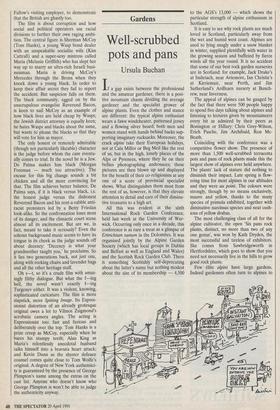Gardens
Well-scrubbed pots and pans
Ursula Buchan
If a gap exists between the professional and the amateur gardener, there is a posi- tive mountain chasm dividing the average gardener and the specialist grower of alpine plants. Even the clothes and stance are different: the typical alpine enthusiast wears a fawn windcheater, patterned jersey and a flowing silver beard; both men and women stand with hands behind backs sup- porting imaginary rucksacks. Moreover, the crack alpini take their European holidays, not at Cala Millor or Beg Meil like the rest of us, but in the high, lonely places of the Alps or Pyrenees, where they lie on their bellies photographing androsaces; these pictures are then blown up and displayed for the benefit of their co-religionists at any one of a score of provincial specialist shows. What distinguishes them most from the rest of us, however, is that they elevate attention to detail and care of their diminu- tive treasures to a high art.
All this was evident at the sixth International Rock Garden Conference, held last week at the University of War- wick. Occurring only once in a decade, this conference is as rare a treat as a glimpse of Eritrichium nanum in the Dolomites. It was organised jointly by the Alpine Garden Society (which has local groups in Dublin and Belfast as well as England and Wales) and the Scottish Rock Garden Club. There is something Scottishly self-deprecating about the latter's name but nothing modest about the size of its membership — 4,500 to the AGS's 13,000 — which shows the particular strength of alpine enthusiasm in Scotland.
It is easy to see why rock plants are much loved in Scotland, particularly away from the wet and humid west coast. Alpines are used to lying snugly under a snow blanket in winter, supplied plentifully with water in the growing season and buffeted by fierce winds all the year round. It is no accident that some of our best rock garden nurseries are in Scotland: for example, Jack Drake's at Inshriach, near Aviemore, Ian Christie's at Kirriemuir, near Perth, and Jim Sutherland's Ardfearn nursery at Bunch- rew, near Inverness.
The appeal of alpines can be gauged by the fact that there were 500 people happy to spend five days talking about alpines and listening to lectures given by mountaineers every bit as admired by their peers as Bonington or Hillary: Chris Grey-Wilson, Erich Pasche, Jim Archibald, Ron Mc- Beath.
Coinciding with the conference was a competitive flower show. The presence of more than 1,500 well-scrubbed terracotta pots and pans of rock plants made this the largest show of alpines ever held anywhere. The plants' lack of stature did nothing to diminish their impact. Late spring is flow- ering time for most alpines in our altitudes and they were au point. The colours were strongly, though by no means exclusively, mauve and yellow, thanks to the many species of primula exhibited, together with diminutive narcissus species and neat cush- ions of yellow drabas.
The most challenging class of all for the alpine cultivator, the open 'Six pans rock plants, distinct, no more than two of any one genus', was won by Kath Dryden, the most successful and tireless of exhibitors. She comes from Sawbridgeworth in Hertfordshire, which goes to show that you need not necessarily live in the hills to grow good rock plants.
Few elite alpini have large gardens. Indeed gardeners often turn to alpines to satisfy their craving for variety when they have too little space for growing much else. It is not a particularly expensive 'hobby', either, for much is grown from seed. `Alpine houses', where most of the magical work goes on, are not heated; the point of them is to keep the plants dry, rather than warm, in winter. Perfection in this field is not, therefore, in theory at least, beyond you and me. If alpines appeal to you but you have never grown them, I would sug- gest you first join the AGS or SRGC. Both publish, in their journals, invaluable and uncondescending articles for beginners. Next grow a beard.
For subscription details, write to the AGS Centre, Avon Bank Pershore, Worcester- shire, WR10 31P, or the SRGC, 21 Merchis- ton Park, Edinburgh EH10 4PW.



























































 Previous page
Previous page